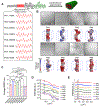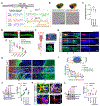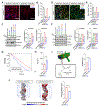Bioactive scaffolds with enhanced supramolecular motion promote recovery from spinal cord injury
- PMID: 34762454
- PMCID: PMC8723833
- DOI: 10.1126/science.abh3602
Bioactive scaffolds with enhanced supramolecular motion promote recovery from spinal cord injury
Abstract
The signaling of cells by scaffolds of synthetic molecules that mimic proteins is known to be effective in the regeneration of tissues. Here, we describe peptide amphiphile supramolecular polymers containing two distinct signals and test them in a mouse model of severe spinal cord injury. One signal activates the transmembrane receptor β1-integrin and a second one activates the basic fibroblast growth factor 2 receptor. By mutating the peptide sequence of the amphiphilic monomers in nonbioactive domains, we intensified the motions of molecules within scaffold fibrils. This resulted in notable differences in vascular growth, axonal regeneration, myelination, survival of motor neurons, reduced gliosis, and functional recovery. We hypothesize that the signaling of cells by ensembles of molecules could be optimized by tuning their internal motions.
Conflict of interest statement
Figures






Comment in
-
A dynamic duo.Science. 2021 Nov 12;374(6569):825-826. doi: 10.1126/science.abm3881. Epub 2021 Nov 11. Science. 2021. PMID: 34762463
References
-
- Silva GA et al., Selective differentiation of neural progenitor cells by high-epitope density nanofibers. Science 303, 1352–1355 (2004). - PubMed
-
- Brandley BK, Schnaar RL, Covalent attachment of an Arg-Gly-Asp sequece peptide to derivatizable polyacrylamide surfaces: Support of fibroblast adhesion and long-term growth. Anal Biochem 172, 270–278 (1988). - PubMed
-
- Hartgerink JD, Beniash E, Stupp SI, Self-assembly and mineralization of peptide-amphiphile nanofibers. Science 294, 1684–1688 (2001). - PubMed
Publication types
MeSH terms
Substances
Grants and funding
LinkOut - more resources
Full Text Sources
Other Literature Sources
Medical

